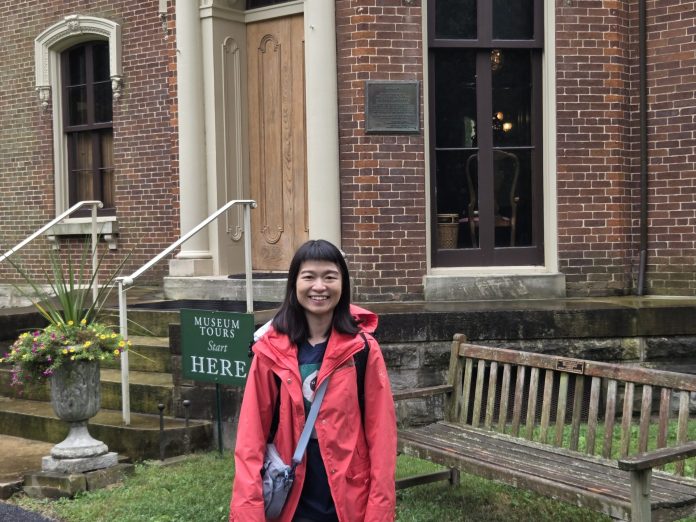After being awarded a prestigious Fulbright fellowship, Yi Ru Lee made the trip from Kaohsiung, Taiwan to Lexington in August to teach Chinese at Transy this academic year. She is also taking classes as a student here. Lee is fluent in English after studying the language for her entire college career.
Known to students as Lee 老师 (laoshi), which means “teacher Lee,” she has been a bright and energetic presence on campus this semester, always expressing her kind nature and openness in talking to students and faculty.
Yi Ru Lee is from Kaohsiung, an artistically and culturally rich city on the southwest coast of Taiwan. She was originally born in Taoyuan, Taiwan, but as a kid moved to Kaohsiung for her parents to find work. She lived there until college and has not been back much since then. However, Lee said, Kaohsiung “is a place of warmth and sense of security” for her to go back to to see family and friends.
On my own trip this Summer with KIIS Taiwan, I myself briefly went to Kaohsiung to visit Pier-2, one of the city’s iconic locations, and stayed the night there during the group’s week-long bus excursion around the country. I only spent a couple days there, but I was curious about the traditions and activity in the area, so I was eager to speak with Lee about the foods, interesting locations, and traditions of Kaohsiung.
The first thing Lee mentioned about her hometown was the “breakfast shops.” Breakfast shops “open at 5 o’clock with super great deals,” she said, and serve a number of foods popular among foreigners and locals alike—including green onion pancakes and Chinese omelets. Chinese omelets are like regular omelets except the eggs are more thinly and delicately spread on a round skillet. There are a variety of fillings available, including vegetables, tuna, and meat. Breakfast shops are often the first stop for Kaohsiung residents to start their day.
Bubble tea shops are another extremely popular and important aspect of daily Taiwanese culture. Bubble tea was founded in Taiwan in the mid-1980s in Taichung. Since then, it has been a staple drink around the world. I asked Yi Ru Lee if bubble tea shops in Taiwan were also utilized as study or work spaces like coffee shops. “In America there is more seating at boba tea shops,” she told me. “However, in Taiwan, there are no sitting places at boba tea shops.”
As for food, Lee said that a popular option was Dandan Hamburger, which has a “mix of Western and Eastern foods.” The restaurant combines the traditional Taiwanese cuisine known as “mian xian fu” (dumplings and soup) with hamburgers, making for a unique culinary fusion. Lee said the meals have portions that are manageable and delicious.
Kaohsiung’s most famous cuisine, Lee said, is its hotpot, particularly “man (满) hotpot,” or “mutton hotpot.” Being a coastal city, it is also incredibly famous for seafood hotpots. There are hotpot locations all over the city (there are around 94 businesses centered around hotpot in the city’s Sanmin District alone). “There are different kinds of hotpot broth that you can choose from,” she said. “My favorite one is either herbal broth or curry broth.”
There are a couple notable celebrations in Kaohsiung as well, Lee said.
“When it comes down to celebrations, pretty similar to the US, we do have the countdown to the New Year,” she said. “The most famous countdown is at Taipei 101 [the tallest building in Taiwan, where people from northern cities congregate for a New Year’s Eve countdown]. But Kaohsiung actually celebrates at Pier-2.”
Pier-2 reflects the artistry of Taiwanese creators. The art located there includes sculptures, bridges, and even entire buildings that are painted over. “I am not an art person,” Lee said, but added that she “enjoyed how cool the symbolism of art was and how you could interpret how you want to view the different pieces of art.”
“A festival that makes Kaohsiung stand out from the rest of Taiwan is the ‘Song Jiang Battle Ritual Festival,’” Lee said. This event occurs on the birthday of a god, namely the god 西秦王爷 (xi qin wang ye). The festival takes place at the end of March, an hour away from Kaohsiung. The 王爷 (wang ye) means higher power or deity ruler.
Lee said that the performance “originated from a form of Chinese Kung Fu. This ritual consists of around 36 people and they will do martial arts in front of god to please them.”
She described how thespians would skillfully perform battles between partners throughout a demonstration of art and history. The reason it is called a “battle ritual,” Lee said, is because “people will engage in sparring.”
But it is not violent, only a performance. Many people participate and watch the event as a celebration and pleasing practice to the gods of musical arts and the god 西秦王爷 (xi qing wang ye). These “battles” are fought with metal weapons, but they are not sharp. Lee explained that the weapons are given special “god stickers” with the “protection of the gods” so that when engaging with another human body, the weapons are blessed and do not harm the other person in any way.
“It’s really local and people do not mention this much online,” she said. “However, foreigners really need to go over and see something like this.”
I agree with Lee that people should try to explore all aspects of countries they visit. And they should try to visit as many countries as they can. Otherwise, you simply rob yourself of a potential new perspective on life. Yes, destinations like Greece, Italy, and Japan are more popular tourist locations—and for great reason—but if you properly take advantage of travel while you are young, you will find out that the world is much more intricate and distinctive than the canvas we have prematurely painted.



